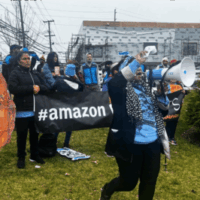Seated in a leather booth at Jalapeño’s Bar and Grill in Boise, Irma Valdivia scrolls through text messages from one of her servers. Forty-five and short in stature, she wears a Chanel pearl necklace nestled against a silky brown shirt — the uniform of a successful businesswoman. “I will now only be working as follows: 5:30 to close Wednesday, Thursday and Friday,” she reads in a deep voice. “Old Irma would have told her, ‘Monique, that’s not gonna work out, thank you and best of luck.’ New Irma says, ‘I gotta figure how to keep her on at least one or two days.’ ”
Amid an uneven economic recovery and the lingering pandemic, many workers have proven reluctant to go back to their jobs, making them a prized resource and something like an endangered species. Depending on who you identify with, either they’re behaving like greedy squirrels hoarding unemployment insurance nuts or like prey that, for once, get to turn the gun on the hunter. Business owners and managers ponder how best to lure a server out of their living room: With bonuses? Increased wages? Time off?
Economists, meanwhile, rattle off the factors holding workers back. Fear of being exposed to a new strain of the coronavirus ranks high on the list, even with vaccines widely available. Low pay, lack of benefits, rigid work schedules and the difficulties of child care follow.
What’s clear is how this scarcity manifests itself — a labor crunch that has hit businesses like a gut punch, especially in the hospitality sector. As of August, the unemployment rate for bar and restaurant workers was 8.7%, about three percentage points higher than the overall rate, according to the Bureau of Labor Statistics.
Jalapeño’s is an exception. The company could use some extra hands for busy shifts, as “hiring” signs indicate. But most of about 100 employees have come back to work for the three-restaurant chain in southwestern Idaho. The Valdivias credit years of building trust with workers, giving them a voice and, more recently, generous financial incentives.
“They actually treat this restaurant like it was their own,” says Leticia Valdivia McLaughlin, Irma’s sister and business partner.
Employers that supported workers prior to the pandemic are less likely to be affected by the shortage, labor experts say. Their financial recovery has also been quicker, putting them in a better position to cushion future economic blows.
“All of these things will probably help them be a step ahead compared to other employers who may not be doing the same thing,” says Yannet Lathrop, a senior researcher and policy analyst at the National Employment Law Project, a research and advocacy group. Jalapeño’s may provide a blueprint for other small businesses that hope to keep attracting employees, even in the midst of a public health crisis.
Watching Irma climb into her sleek black Range Rover, you could be forgiven for guessing that she comes from money, though she built her business from scratch. The SUV’s rear plate reads, in black letters, “PATRONA,” a Spanish term for a female boss. But she wasn’t exactly born with a silver spoon in her mouth. She grew up in a family of 10 children, raised by Mexican immigrants who toiled away in the fields around Boise in the 1970s. Later, she and her brothers worked for an uncle who owns a restaurant and the family was inspired to start their own.
Irma partnered with her sister, and they settled on a Mexican cantina. After opening the first location in Nampa in 2006, they expanded with another in Boise three years later. In 2019, they opened a third store four blocks from Boise State University. Each sibling manages a location, but they often make important decisions as a team. This doesn’t mean that they agree on everything. In March 2020, their partnership was put to its biggest test yet.
Near the end of that month, Idaho’s governor issued a stay-at-home order to limit the spread of the coronavirus. The Valdivias faced a tough choice: Would they remain open and provide curbside orders or shut down indefinitely? How many employees would they keep? Sitting in a freezing-cold office, they went back and forth. “It was like beating a dead horse,” says Leticia, 51.
Mike, a baby-faced 37-year-old, favored shutting down, worried about getting himself or his staff exposed to the virus. His sisters, however, preferred to stay open as long as they could — as long as their employees were on board.
Businesses across the country had to make similar choices. When researchers surveyed 5,800 small businesses about their response to the pandemic, they found that those in the food service industry cut payroll by more than half, according to an article published in the Proceedings of the National Academy of Sciences. More than 1 in 3 restaurant workers filed for unemployment in the spring of 2020, according to the Bureau of Labor Statistics.
In the end, the Valdivias agreed to disagree. The sisters stayed open and Mike ended up closing his location. On the last day, his roughly 20 employees filed out of the restaurant, carrying bags filled with perishable food. The workers who most needed the money — those with mortgages and families — were sent to another location to help fill pickup orders. Those who were still in high school volunteered to go on unemployment, as did some of the younger workers at the sisters’ restaurants.
A few days later, Katy Marrow, 29, and a handful of employees gathered around Leticia in the kitchen of her restaurant. They’d have to go on unemployment for now, until the Valdivias worked out how to bring employees back safely. But all agreed to come back to work as soon as they could, coronavirus or not.
Marrow had been in the service industry for over 10 years but had never been furloughed. Suddenly, she had to worry about successfully applying for benefits. “It was a scary thought — being without money or a job,” she says. She soon learned that the additional $600 provided each week under the Coronavirus Aid, Relief, and Economic Security Act amounted to just half of what she made in tips.
But the money wasn’t all that she missed. At Jalapeño’s, she found working conditions a world apart from the corporate restaurants where she’d worked. “We’re all a lot closer,” says Marrow. After only two weeks, she put on her black uniform T-shirt and headed back to work, right as the restaurant settled into a new rhythm. Masked cooks prepared meals for her to pack into as many as four boxes. Phone lines were added to keep up with the growing volume of calls. Online ordering became an option. The patio in front of the restaurant was reconfigured to serve as a drive-thru. Loyal customers streamed by, picking up $30 foil containers filled with tacos and leaving generous tips behind.
There’s a central thread running through the tapestry of complaints voiced by business owners since the economy surged back to life, alongside supply chain backlogs and vaccine mandates: Workers don’t want to work anymore. The alleged culprit? Unemployment benefits. In the eyes of many, would-be employees would rather stay at home and game the system.
A few months ago, 26 states — 25 controlled by the GOP, including Idaho, Wyoming, Utah and Arizona — picked the stick over the carrot and discontinued some or all supplemental programs enacted by Congress, including a measure that provided supplemental unemployment benefits until it was discontinued in September.
Yet, these states saw no noticeable increase in job growth compared with those that maintained the aid, The Wall Street Journal found. Workers in the 22 states that ended all additional benefits in June were only slightly more likely to find a job, according to a team of economists. It’s possible that some “workers earning more with enhanced unemployment insurance benefits than they did working may have decided that low-paid jobs weren’t worth the risk in the middle of a pandemic,” says the National Employment Law Project’s Lathrop. But the takeaway shouldn’t be that low-paid employees are slackers. If anything, she says, “it does say something about how depressed wages have been for a long, long time.”
Read the full article at Deseret News
Related to
The Latest News
All newsMayor Bowser & D.C. Council Must Respect the Will of D.C. Voters by Rejecting Repeal of Initiative 82

Blog
New Brief Sheds Light on the Amazon’s Dangerous ‘Flex’ Labor Model

News Release
NELP Denounces Supreme Court Ruling Permitting Immediate Layoffs of Hundreds of Thousands of Federal Workers

News Release
